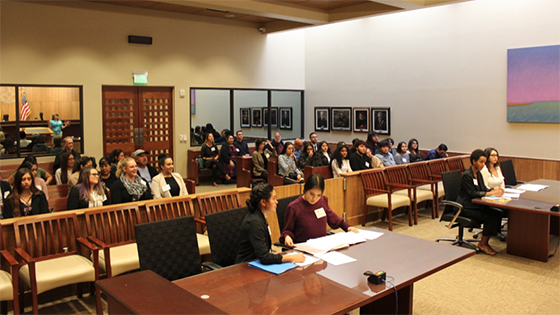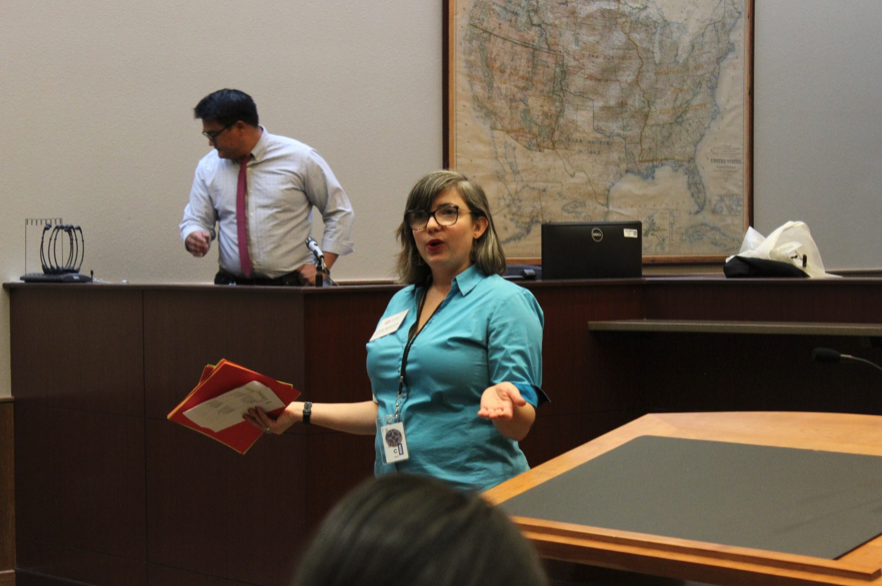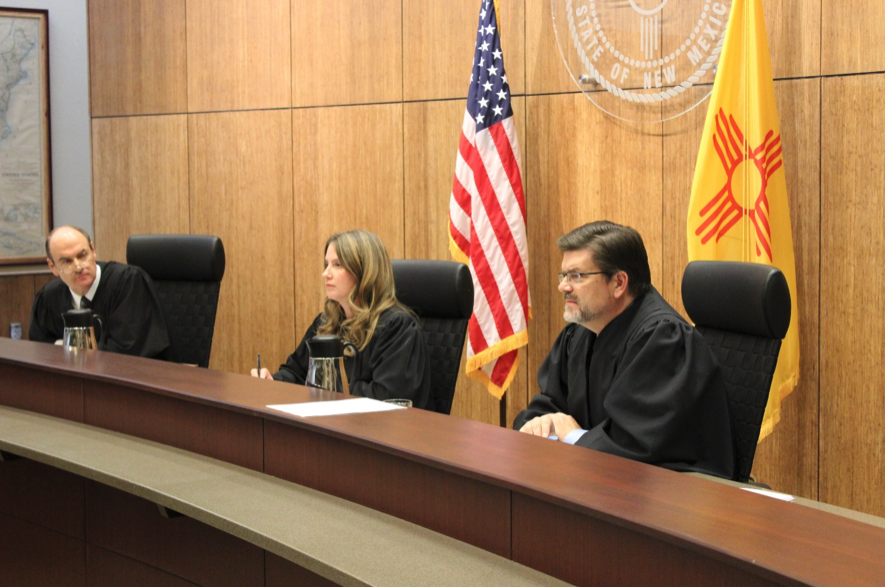The Impact of the Marshall-Brennan Project Continues
November 27, 2019 - Sal Guardiola II

Audience members in the gallery brace themselves for the final round of the competition while the finalists await the judges’ grand entrance. Photo by Sal Guardiola II
Among the goals of the Child & Family Justice Initiative (CFJI) is to build a pipeline to UNM School of Law by exposing young people of diverse backgrounds underrepresented in the legal field to the possibility of a career in law. Year after year, UNM Law hosts the Marshall-Brennan High School Regional Moot Court Competition. This year, Lalita Moskowitz (’18), Staff Attorney and Equal Justice Works Fellow at the ACLU of New Mexico, served as Director and adjunct professor for the UNM Law Chapter of the Marshall-Brennan Constitutional Literacy Project. Bringing her passion for constitutional rights and her experience as a former Marshall-Brennan Fellow to the table, she inspired law students to bring their best to the various high school classrooms they taught at each week through the program.
Words from current Marshall-Brennan Fellow and UNM Law student Kateri Garcia West (’21) described the impact of this program:
Marshall-Brennan brings out success stories in our community. The program opened up a world of opportunities to students who otherwise might not even consider attending college. Our first week at Highland High School, my partner Hope Pendleton (’21) and I asked the students, what career would they choose if they could do anything? Not a single student wanted to be a lawyer, and only one student said she even wanted to go to college.
We are confident the experience has encouraged our students to see that college is within their reach. The Marshall-Brennan regional competition had many behind-the-scenes successes and tear-worthy moments . . . .
One student in our class, G.S. has elected never to speak. Only his school counselor has any idea why. We were able to engage him through writing assignments, including writing a short brief for the respondent in the moot court problem. We also brought him onto the regional team as a strategist because we recognized that he saw the problem from different angles. He wrote questions to ask the team as they practiced their oral arguments. The day before the regional competition at UNM, G.S. wrote, “If somebody does not show up, may I compete?” We asked if he would be willing to practice to demonstrate he could do it. And he did. Hearing the voice of this amazing student for the very first time as he read his argument aloud brought tears to our eyes. He was motivated. The day of the competition, one of our students did not show up, and G.S. argued in her place. His high school teacher, Mr. Frausto, informed us that G.S. has taken the ACT and is applying to UNM next fall. He wants to study psychology. Mr. Frausto has shown an unwavering dedication and support for his students.
Another amazing student in our class was A.E. He was one of the most quiet students in our class, who unfortunately had many absences. He delivered a very strong argument for the respondent, though, and tied with three other students for the fourth spot on the regional team. We had a tiebreaker competition, and A.E. again stepped up and showed that he was made for the team. The week of the competition, however, A.E. was not at school for two of the three days of practice, and we were not sure he would be able to compete. The morning of the competition, since one of the students who was supposed to argue for the petitioner did not show up, A.E. stepped up and rewrote his entire argument to argue for the petitioner. He did not get a chance to practice before stepping into the first round of competition. He fielded tough questions with composure and gave specific answers to the questions asked, never yielding from his position. At the end of the competition, Mr. Frausto informed us, “I don’t know if you were aware, but A.E. is classified as ‘special ed.’ His beautiful arguments left me stunned.” This competition gave A.E. the chance to show what he is capable of.
Finally, a student who is an English Language Learner, L.P., joined the class midway into the semester, but she showed that she wanted to compete. With the help of two other Marshall-Brennan Fellows, Taylor Noya (’21) and Adrian Gandara (’20), and Google Translate, we translated the moot court problem and cases into Spanish for L.P. She studied the cases and learned how to analogize and differentiate to case law. She made her best effort to argue in English, but ultimately asked to have a translator help her. Jessica Martinez (’21), a Marshall-Brennan Fellow, took time out of another class of hers to help translate L.P.’s arguments for the court. In the second round, one of the judges spoke Spanish and translated for the panel L.P.’s arguments. L.P. was told that she made powerful points in arguing the difference between political speech and personal attacks. She was told she was brave, and a judge who did not speak Spanish said that although he could understand very little of what she said, her style and demeanor came across, and he loved that she made eye contact with the panel. She was told that she had the potential to be a great lawyer someday.
That is what this competition is all about, and I am so grateful for the opportunity.

Director and adjunct professor for the UNM Law Chapter of the Marshall-Brennan Constitutional Literacy Project Lalita Moskowitz (’18) provides of overview of what to expect during the final round of the competition. Photo by Sal Guardiola II
Through the Marshall-Brennan Project, young people across the city of Albuquerque are challenged to believe beyond what they think themselves capable of through the encouragement of UNM Law students serving as Marshall-Brennan Fellows. The benefit is mutual as UNM Law students find themselves enriched by the opportunity to see the young people before them grow in confidence and hope for the future. Marshall-Brennan Fellow and UNM Law student Isaac López (’21) shed light on his experience throughout the semester:
Working closely with students, I learned their backgrounds and heard their stories. I can say without hesitation that the Marshall-Brennan program had a significant impact on most, if not all, the students in the classroom. One student in particular, J.P., had an incredible transformation throughout the semester. J.P. is a sophomore at Highland High. He is also a successful amateur boxer. However, J.P. did not see a high school graduation in his future. He felt he was not smart enough, nor good enough. The first few class sessions, J.P. was quiet, but I could tell he was intrigued and playing close attention. As time went on, J.P. became involved, often raising his hand and adding to the discussion. I would often walk into class before the students got back from lunch, but I would see J.P. reading his pocket constitution alone in the classroom.

Left to right: U.S. District Court Judge James O. Browning, New Mexico Court of Appeals Judge Megan P. Duffy (’08), and New Mexico Chief Public Defender Bennett Baur put the finalists to the test with their barrage of questions. Photo by Sal Guardiola II
At Highland High, we had a moot court competition to select our finalist to participate in the regional competition. On the day of competition to select our finalist, J.P. was in the classroom at 7:00am until the competition at 12:40pm practicing his arguments. J.P. volunteered to go first and thought he was not going to get selected, again thinking he was not smart enough. J.P. gave an amazing argument and was selected to participate in the regional competition. Again, at the regional competition, J.P. delivered amazing arguments and had the fourth highest score in the competition. To see his face beaming with happiness and confidence was truly inspiring and amazing. J.P. expressed to me that he has never felt so good before and stated that he was so grateful for the experience. It is students like J.P. that make Marshall-Brennan the great program that it is, and I know there are many more like him in Albuquerque.
The Regional Moot Court Competition wrapped up with a final round in the New Mexico Court of Appeals. This year, the volunteer three-judge panel consisted of U.S. District Court Judge James O. Browning, New Mexico Court of Appeals Judge Megan P. Duffy (’08), and New Mexico Chief Public Defender Bennett Baur. Many members of the New Mexico Bar read those names and understand that arguing before such astute legal minds is no small feat. The finalists accomplished precisely that and did so with dignity. Rest assured that New Mexico will be well-represented at the National Marshall-Brennan High School Moot Court Competition at Rutgers University in spring 2020.
If you would like to support the UNM School of Law Chapter of the Marshall-Brennan Constitutional Literacy Project, you can do so here. For more information about the Child & Family Justice Initiative, please contact Sal Guardiola II at guardiola@law.unm.edu or at 505-277-9065.
